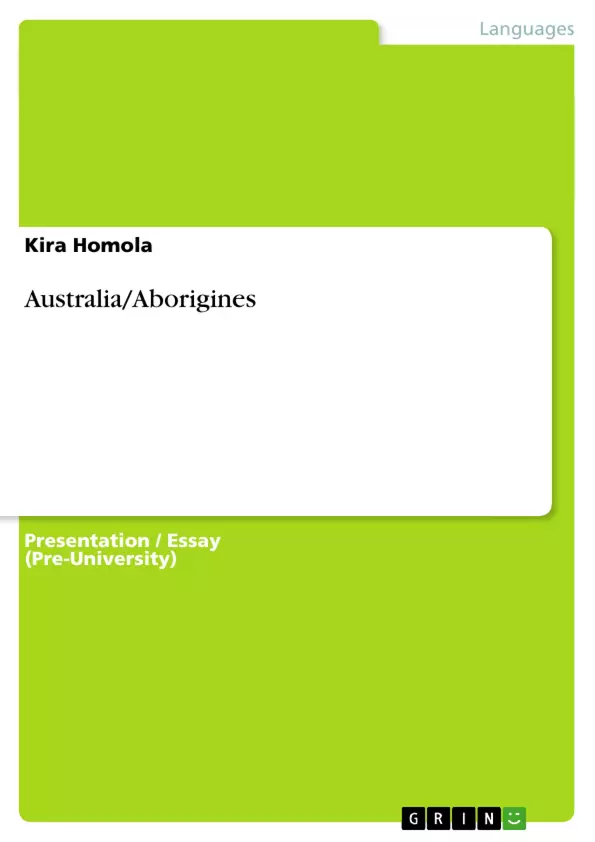Aborigines
Australia has only been known to "the world" for about 400 years. It was discovered in 1605 by mistake by the Dutch sailor Willem Jansz during a trip to New Guinea. In the 1770ies the British explorer James Cook sailed to the area. He found Australia’s east coast and made a British claim on the land he found. He called it New South Wales. The European sailors who landed on the coasts of the newly discovered continent met people who called themselves Kooris. Koori tribes have lived in Australia for more than 40,000 years. The sailors called them "Aborigines." Originally, the Aborigines came from somewhere in Asia. This was at a time when there was an almost continous land bridge between Asia and Australia.
During the first half of the 19th century the British established new colonies in Australia. This led to confrontations with the Kooris who wanted to defend their land and culture. The Aborigines were hunters and collectors, which means that the hunted, fished and collected fruit and vegetables from nature to get food. More than 200 different languages were spoken and almost all Aborigines were bilingual or multilingual. There may have been about 500 different tribes of these native people. The Aborigines had no chiefs or other centralized institutions of political control. The Aborigines divided the year into five to eight seasons marked by the different climatic conditions. It is estimated that there were approximately 300,000 to 1 million Aborigines living in Australia when the British came to the continent.
The British saw Australia as a rich country ideal for farming, agriculture and animal husbandry. When they started building large farms and keeping animals there, the Aborigines kept on living as they had always done. They continued to hunt and collect as the grandfathers and grand- grand-fathers did. The white settlers took ever more land away from the Aborigines. This lead to confrontations between the British and the Aborigines. Since the British weapon technology was superior to the spears of the Aborigines, the British won almost all the fights and battles, and the Kooris were almost wiped out.
Many of the Aborigines were killed, and the remaining were forced to adapt to the British way of life. They were forced to work as helping hands and servants at farms owned by whites or to move to the cities to work in industrial factories.
In the early 20th century, the white Australian population started to become more aware of the Aborigines' situation. Special reservations were established where the aboriginal tribes could live like they had done before the British invasion. However, these reservations were often too small. There were also only a few of them so that only a small percentage of the Aborigines had a chance to live there. Therefore, the Aborigines continued to live under poor conditions and they continued to fade in numbers.
In 1940, there were only about 35 thousand Aborigines left in Australia.
Frequently asked questions
What is this document about?
This document provides an overview of the history and current situation of the Aborigines in Australia, focusing on their interactions with European settlers.
When was Australia discovered by Europeans?
Australia was discovered in 1605 by Dutch sailor Willem Jansz and later explored by the British explorer James Cook in the 1770s.
Who are the Kooris?
The Kooris are the indigenous people who lived in Australia for over 40,000 years before European settlement. European sailors called them "Aborigines."
Where did the Aborigines originally come from?
The Aborigines originally came from somewhere in Asia when there was a land bridge between Asia and Australia.
How did the British colonization impact the Aborigines?
British colonization led to confrontations with the Aborigines as the settlers took their land. The Aborigines were forced to adapt to the British way of life, often working as laborers or moving to cities.
What happened to the Aborigines as a result of colonization?
Many Aborigines were killed in conflicts or succumbed to disease. The remaining Aborigines were forced to adapt to the British way of life, losing their traditional lands and ways.
What were the living conditions like for Aborigines in the 20th century?
In the early 20th century, reservations were established for Aborigines, but these were often too small and few in number. As a result, Aborigines continued to live in poor conditions.
How many Aborigines were left in 1940?
By 1940, there were only about 35,000 Aborigines left in Australia.
What is the situation of Aborigines in Australia today?
Today, Aborigines make up about 1% of Australia’s population. They still face challenges, with high unemployment rates and lower average wages compared to the national average.
What is the government doing to improve the lives of Aborigines?
The Australian government is trying to improve the living standards of Aborigines, but many of them still belong to the poorest group in society.
- Arbeit zitieren
- Kira Homola (Autor:in), 1999, Australia/Aborigines, München, GRIN Verlag, https://www.grin.com/document/95530



